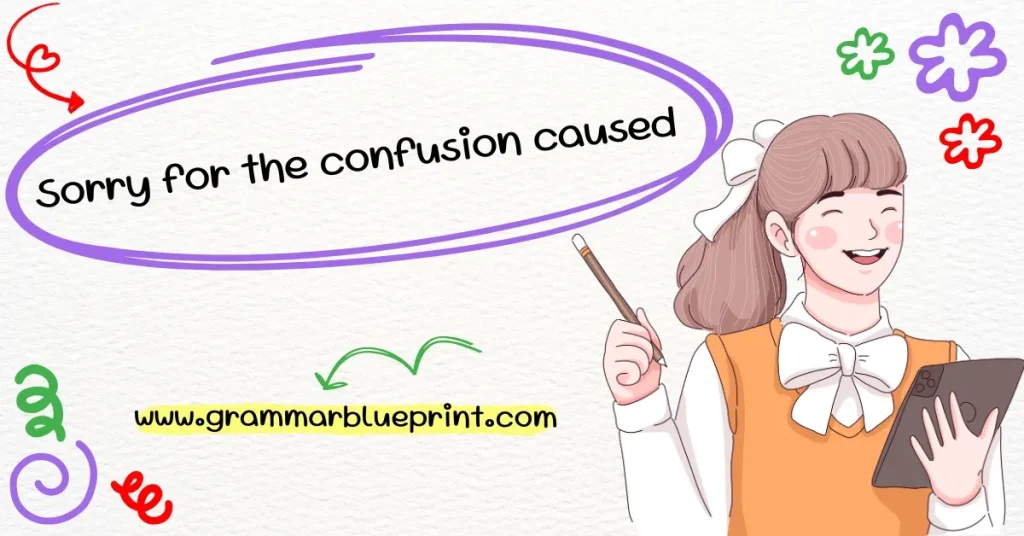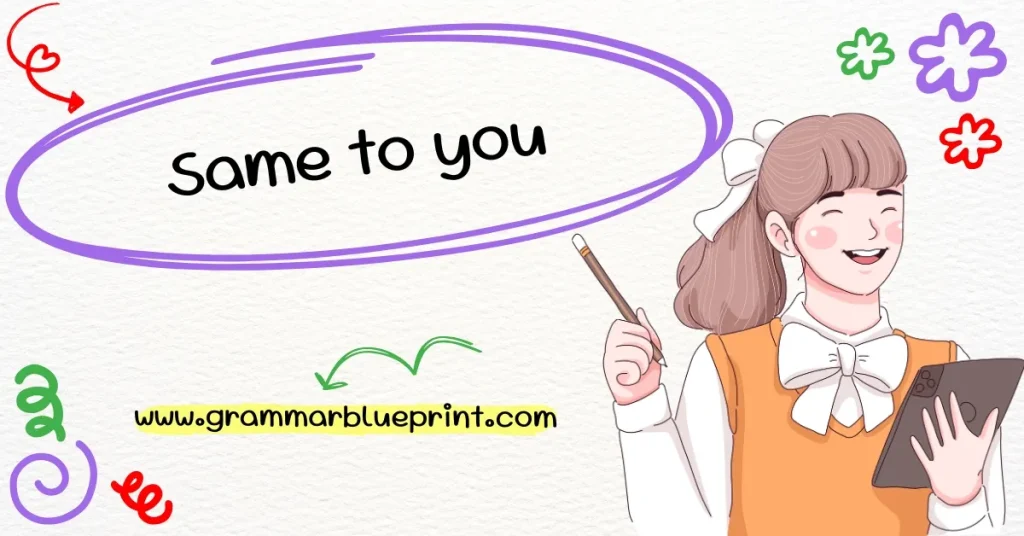We’ve all experienced confusion at some point in our lives, whether in personal conversations or professional settings. It’s common to find ourselves in situations where something wasn’t clearly understood, leading to a need to apologize. One phrase often used in such scenarios is “Sorry for the confusion caused.” This simple yet powerful expression can help ease tension, clarify misunderstandings, and restore clear communication. In this article, we’ll explore the meaning, importance, and various ways to apologize when confusion arises, especially in English.
What Does “Sorry for the Confusion Caused” Mean?
“Sorry for the confusion caused” is a phrase used to acknowledge and apologize for a misunderstanding or miscommunication. It’s typically used when something you said or did led to confusion or a lack of clarity.
This phrase serves as an expression of regret for the misunderstanding and is commonly used to smooth over any tension or discomfort caused by the situation. It’s important to note that an apology like this is not just about saying “sorry,” but also about clarifying and offering a solution or explanation to prevent further confusion.
Why Apologizing for Confusion Is Important
Apologizing for confusion is crucial because it shows respect for the other person’s feelings and a willingness to take responsibility. Misunderstandings can cause frustration, stress, or even damage relationships, especially if not addressed quickly.
By apologizing, you acknowledge that communication was unclear, and you make the effort to improve the situation. It also builds trust in relationships, as it demonstrates accountability and emotional intelligence. When people feel heard and understood, they are more likely to feel valued, leading to better cooperation, stronger bonds, and smoother communication.
When to Use “Sorry for the Confusion Caused”
You can use “Sorry for the confusion caused” in both formal and informal settings, but the tone will vary depending on the context.
Formal Situations
- Emails: When a message might have been unclear or if someone misunderstood your instructions, you can apologize in emails by saying, “Sorry for the confusion caused in my previous email.”
- Meetings: If you notice someone is confused by your explanation or presentation, you could say, “I apologize for the confusion caused earlier. Let me clarify.”
Informal Situations
- Text messages or chats: If a casual conversation leads to confusion, a simple “Sorry for the confusion!” can clear things up.
- In-person conversations: It’s also common to apologize for confusion when talking face-to-face, especially when explaining something complex or when the other person looks lost.
In some cases, using phrases like “Sorry about that” or “My bad” might be more fitting, especially in informal situations where the confusion wasn’t serious.
How to Apologize for Confusion in a Professional Setting
When apologizing for confusion in a professional setting, your tone should remain polite and respectful. Use formal language, especially in emails, and always aim to clarify what led to the misunderstanding. Here are some guidelines for crafting a professional apology:
- Be clear and concise: Start by acknowledging the confusion and provide a brief explanation.
- Take responsibility: Avoid blaming others or making excuses. Acknowledge your role in the confusion.
- Offer a solution or clarification: After apologizing, make sure to clarify the misunderstanding and ensure the other person understands.
For example:
“Dear [Name],
I apologize for the confusion caused regarding our meeting time. It seems I made an error in scheduling. To clarify, the meeting will be held at [correct time]. Please let me know if this works for you.”
How to Apologize for Confusion in Casual Conversations
In casual conversations, the apology doesn’t need to be formal, but it should still be sincere. You can say something like:
- “Oh, sorry for the confusion!”
- “My mistake, I didn’t explain that well.”
- “I didn’t mean to confuse you, sorry about that.”
A casual apology like this helps maintain a friendly, comfortable atmosphere. The tone should reflect the casual nature of the interaction, so keep it lighthearted while still acknowledging the misunderstanding.
Common Mistakes to Avoid When Apologizing for Confusion
While apologizing for confusion is important, there are some common mistakes you should avoid:
- Over-apologizing: Saying “sorry” too many times can make you seem insincere or too focused on your own guilt rather than addressing the issue.
- Being vague: A vague apology like “Sorry for the mess” without clarifying the confusion doesn’t resolve the issue. It’s better to explain what caused the confusion and how you plan to fix it.
- Not following up: Apologizing without providing clarification or additional information can leave the other person still unsure. Always offer a solution or explain what went wrong.
Benefits of Apologizing for Confusion
Apologizing for confusion brings numerous benefits:
- Improved relationships and trust: Acknowledging confusion helps rebuild trust, especially if the misunderstanding affected a relationship.
- Prevents further misunderstandings: Clarifying what went wrong can prevent similar issues from arising in the future.
- Demonstrates empathy and responsibility: Taking responsibility shows maturity and consideration for the other person’s feelings.
- Reduces stress: Resolving misunderstandings quickly can alleviate tension, creating a more positive environment in both personal and professional settings.
Better Alternatives to Say “Sorry for the Confusion Caused”
Sometimes, you might want to express yourself differently. Here are several alternatives to saying “Sorry for the confusion caused,” along with their meanings, best uses, and examples:
Apologies for the misunderstanding
-
- Meaning: Acknowledging that something was misunderstood.
- Best Use: When the person misunderstood a concept or idea.
- Example: “Apologies for the misunderstanding. Let me clarify the process for you.”
I apologize for the mix-up
-
- Meaning: A more casual way to acknowledge a mistake.
- Best Use: In informal settings when there has been a simple error.
- Example: “I apologize for the mix-up with the dates. I’ll resend the correct information.”
Please forgive the confusion
-
- Meaning: A polite way of asking for forgiveness for causing confusion.
- Best Use: When you feel the confusion may have caused inconvenience.
- Example: “Please forgive the confusion; I will send you a more detailed explanation shortly.”
I regret the confusion
-
- Meaning: A formal way to express regret about causing confusion.
- Best Use: Professional settings or when the confusion was significant.
- Example: “I regret the confusion surrounding the report. Let’s review it together.”
Sorry for the unclear message
-
- Meaning: Apologizing for sending a message that wasn’t clear.
- Best Use: When an email or text message wasn’t easy to understand.
- Example: “Sorry for the unclear message; I’ll explain it more clearly now.”
Sorry for the misunderstanding
-
- Meaning: Acknowledging that something was misunderstood by the other person.
- Best Use: When the confusion is due to a misinterpretation or miscommunication.
- Example: “Sorry for the misunderstanding. Let me clarify what I meant.”
Apologies for the oversight
-
- Meaning: Apologizing for missing something important or making a mistake due to neglect.
- Best Use: In situations where you missed a detail or failed to address something correctly.
- Example: “Apologies for the oversight. I’ll fix it right away.”
I apologize for the miscommunication
-
- Meaning: A formal way to acknowledge that the exchange of information wasn’t clear.
- Best Use: When there was an issue with how information was exchanged, especially in business settings.
- Example: “I apologize for the miscommunication in our last email. Here’s the corrected version.”
Please forgive the confusion
-
- Meaning: Asking for forgiveness for causing confusion in a more formal tone.
- Best Use: When the confusion may have caused inconvenience or frustration.
- Example: “Please forgive the confusion. I’ll clarify the details shortly.”
I regret the confusion
- Meaning: A formal and polite way to express regret over causing confusion.
- Best Use: In professional or serious situations when the confusion needs to be addressed delicately.
- Example: “I regret the confusion regarding the contract. Let me explain the terms more clearly.”
I’m sorry for the error
- Meaning: Apologizing for a mistake or wrong action that led to confusion.
- Best Use: When the misunderstanding was caused by a clear error or mistake.
- Example: “I’m sorry for the error in the instructions; let me provide the correct details.”
Apologies for the misinterpretation
- Meaning: Acknowledging that something was misinterpreted or misunderstood.
- Best Use: When your words or actions were misinterpreted.
- Example: “Apologies for the misinterpretation. I will explain the situation more clearly.”
Sorry if I caused any confusion
- Meaning: A more casual and humble way to express regret for creating confusion.
- Best Use: In casual settings where the situation may not have been critical.
- Example: “Sorry if I caused any confusion with my previous message.”
Please excuse the misunderstanding
- Meaning: A polite way of asking someone to overlook or forgive the misunderstanding.
- Best Use: When you want to smooth over a small misunderstanding.
- Example: “Please excuse the misunderstanding. I’ll explain what I meant.”
I’m sorry for the lack of clarity
- Meaning: Apologizing for not being clear enough in your communication.
- Best Use: When the problem arose from not expressing yourself clearly.
- Example: “I’m sorry for the lack of clarity in my message. Here’s the correct explanation.”
I apologize for the lack of understanding
- Meaning: Apologizing when the other person didn’t fully grasp your message or idea.
- Best Use: When the confusion results from the other person’s lack of understanding, not from miscommunication.
- Example: “I apologize for the lack of understanding. Let me rephrase that for you.”
Sorry for the mix-up
- Meaning: Informally acknowledging that there was a mistake or error.
- Best Use: When the confusion was caused by a simple error or mix-up.
- Example: “Sorry for the mix-up. I’ll send you the correct details shortly.”
Apologies for the confusion earlier
- Meaning: Apologizing for confusion that happened earlier in the conversation or situation.
- Best Use: When the confusion occurred in the past and needs to be addressed.
- Example: “Apologies for the confusion earlier. Let me clarify the situation now.”
Sorry for any inconvenience caused
- Meaning: Apologizing for any trouble or disruption caused by the confusion.
- Best Use: In professional settings when the confusion may have caused inconvenience to the other party.
- Example: “Sorry for any inconvenience caused by the delay in communication.”
I’m sorry for the unclear explanation
- Meaning: Apologizing for giving an explanation that wasn’t clear enough.
- Best Use: When your explanation was difficult to understand.
- Example: “I’m sorry for the unclear explanation. Let me walk you through it again.”
I apologize for the error in communication
- Meaning: A formal way to acknowledge that something went wrong in the communication process.
- Best Use: In professional or official communication when the error in communication needs to be formally addressed.
- Example: “I apologize for the error in communication regarding the deadline.”
Sorry if my message wasn’t clear
- Meaning: A casual way of acknowledging that your message may not have been understood.
- Best Use: When you suspect the other person didn’t fully grasp your point.
- Example: “Sorry if my message wasn’t clear, I’ll explain in more detail.”
Apologies for the misinterpretation of information
- Meaning: Apologizing when the information shared was misunderstood.
- Best Use: When the recipient misunderstood the meaning or context of the information provided.
- Example: “Apologies for the misinterpretation of information. I’ll provide the correct facts now.”
Please accept my apologies for the confusion
- Meaning: A formal and polite way to offer an apology for the confusion.
- Best Use: In formal written communication or when you want to show respect.
- Example: “Please accept my apologies for the confusion regarding the schedule.”
I regret any confusion caused
- Meaning: Politely expressing regret about the confusion, indicating it wasn’t intended.
- Best Use: When addressing someone after a situation where confusion could have been avoided.
- Example: “I regret any confusion caused by my previous email. Let me provide more details.”
Sorry for the unclear instructions
- Meaning: Apologizing for giving instructions that were hard to follow or ambiguous.
- Best Use: When providing unclear guidance that led to confusion.
- Example: “Sorry for the unclear instructions. Here’s a step-by-step guide to clarify.”
I apologize for the disruption
- Meaning: Apologizing when the confusion caused an interruption or disruption in the normal flow.
- Best Use: When confusion caused a disruption in plans or a project.
- Example: “I apologize for the disruption caused by the confusion. Let’s continue.”
I apologize for the confusion earlier in the conversation
- Meaning: Apologizing for confusion that arose earlier in a discussion or exchange.
- Best Use: When the confusion happened earlier and now requires clarification.
- Example: “I apologize for the confusion earlier in the conversation. Let me clarify.”
Sorry for any confusion in the details
- Meaning: Apologizing for the unclear or mixed-up details that led to confusion.
- Best Use: When specific details or facts weren’t clear and caused a misunderstanding.
- Example: “Sorry for any confusion in the details. Let me correct that for you.”
Apologies for the lack of clarity in my message
- Meaning: Apologizing when the message lacked clear explanation or detail.
- Best Use: When your communication could have been more transparent or detailed.
- Example: “Apologies for the lack of clarity in my message. I’ll explain it better now.”
Each of these alternatives has slightly different nuances, so choose one based on the tone of your message and the context.
How to Prevent Confusion from Happening in the First Place
Clear communication is the key to avoiding confusion in the first place. Here are some tips to help prevent misunderstandings:
- Be specific: Avoid vague statements. Provide as much detail as necessary to ensure clarity.
- Confirm understanding: After explaining something, ask if the other person understands or needs further clarification.
- Use active listening: Pay close attention when someone is speaking to make sure you fully understand their point of view.
- Check for non-verbal cues: In face-to-face communication, body language and facial expressions can give you hints about confusion.
- Clarify immediately: If you notice confusion, address it as soon as possible to avoid miscommunication.
By taking these steps, you’ll be able to communicate more effectively and reduce the chances of confusion in the future.
In conclusion, apologizing for confusion is an essential skill in both personal and professional communication. Whether you use “Sorry for the confusion caused” or one of its many alternatives, the key is to acknowledge the misunderstanding, clarify the situation, and ensure that the conversation moves forward smoothly. By doing so, you’ll not only resolve confusion but also strengthen relationships and improve communication.



